Q&A – Ask Neil: October 10, 2024
(Please read these instructions carefully.)
Before you post your question, please look at recent issues to see if someone else has already asked it. You might find your answer there.
How to submit your question…
(Note: You may need to allow a pop-up window to come up in order to get the link for sending your photo(s). If you have already submitted your question and didn’t see the pop-up window, please click here.)
• Click the link provided below to post your question. After you submit your question, a new window will pop up giving you the address to which you can e-mail a SHARP, HIGH-RESOLUTION PHOTO to accompany your question. Please DO NOT SEND THUMBNAIL PHOTOS in case I need to zoom in to see things.
• Click here to post your question.
• Please ONLY POST YOUR QUESTION ONE TIME. We can only accept a set number of questions each week, and when we get duplicates it costs other people their chances.
• One question per reader, please.
• Please use this only for posting questions – not for standard emails.
• Watch for your answer in the following week’s e-gardens.
• I choose those of greatest general interest. For example, plant IDs seldom make the cut.
• I must have your first name or initials.
• I must have your city or county. (Texas is a very large state.)
QUESTION 1
HOW DO I GET RID OF FIRE ANTS IN RAISED VEGETABLE BEDS?
Question: How do you get rid of fire ants in raised vegetable beds? Steve V., Ellis County.
Answer: Most of the individual mound treatments you would use in your turf could be used in empty gardens during the winter when there were no vegetables growing actively. The products should list the prescribed waiting period before you would be able to replant in the treated soil. In many cases it should be by the following spring. The even better way would be to use one of the bait products cleared for such use. These are intended to be applied around the perimeter of the garden so that the worker ants can forage and pick up the insecticide-laden bait and carry it back to the mound to the queen. Some of these products are even labeled to be applied within the garden itself. You have plenty of good options. Let a Texas Certified Nursery Professional at a member of the Texas Nursery and Landscape Association show you the various products.
QUESTION 2
WILL MY PRE-EMERGENT STILL BE EFFECTIVE AFTER ALL THIS WARM FALL WEATHER?
Question: A while back, when we had that brief spell of cool weather, it was recommended that I put down pre-emergent for burweed. I did that and watered it in well. Now, with this current warm stretch, will it still be effective? Ben B., Franklin, Robertson County.
Answer: Assuming you applied one recommended for the obnoxious burweed, it should still be fine. The good news is that burweed is a broadleafed plant so you do get a second chance with it. You can spray any of the weed that escapes the pre-emergent with a broadleafed weedkiller in a few weeks. It should be easy to control even after it germinates.
QUESTION 3
HAVE I KILLED MY LACEBARK ELM TREE? I WRAPPED ITS TRUNK AND USED YARN TO SECURE IT.
Question: I planted a new lacebark elm tree in October 2023. I wrapped the trunk for protection and I used yarn to secure it. The trunk grew larger than I expected and has enveloped the yarn. Will the trunk always be weak at that spot? Phyllis C., McKinney.
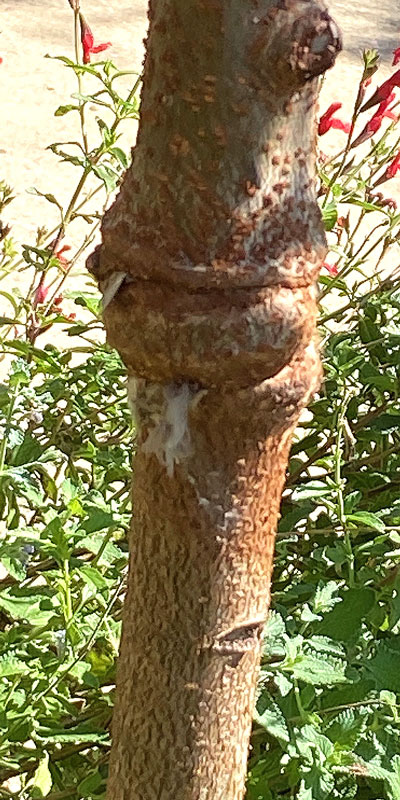
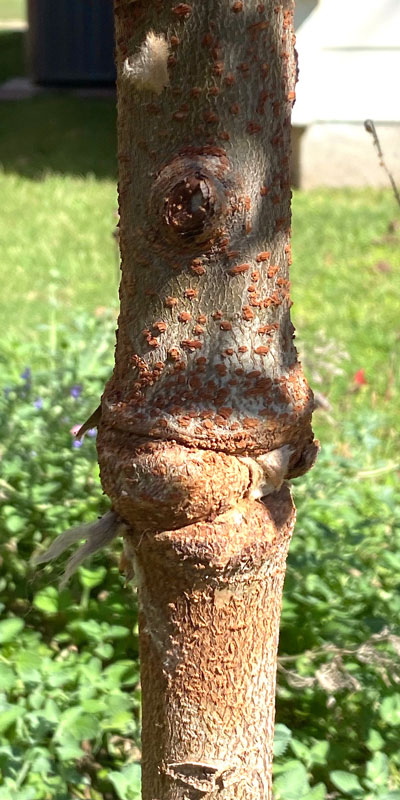
Answer: When you get that kind of overgrowth it means that sugars manufactured in the leaves are accumulating above the constriction. I still see some of the yarn sticking out. I don’t know if there is a complete piece of it still in place. That would be bad, but so would be cutting a hole so you could slice through it. In all candor, lacebark elms have enough other serious problems anyway, I’m not sure I’d spend a lot of money trying to save this tree. They’re susceptible to cotton root rot, the soil-borne fungus that kills even mature trees within a week or two. Our son lives in McKinney, and I’ve watched a dozen of more die on Cotton Ridge in the past 3 or 4 years. Lacebarks also lean – they don’t seem to be able to hold themselves upright. I would leave the tree in place and see if it can outgrow this issue next year. If it can’t, switch over to a better species such as one of the oaks, Chinese pistachios, magnolias, or cedar elms.
QUESTION 4
HOW CAN I NURSE MY FORSYTHIA BACK TO HEALTH?
Question: I planted a forsythia in the southwest corner of a new perennial bed in late winter. It has clearly been mistreated. Do you have any advice on how I can nurse it back to health? It seems to be deteriorating rapidly. Jan H., The Colony, Denton County.
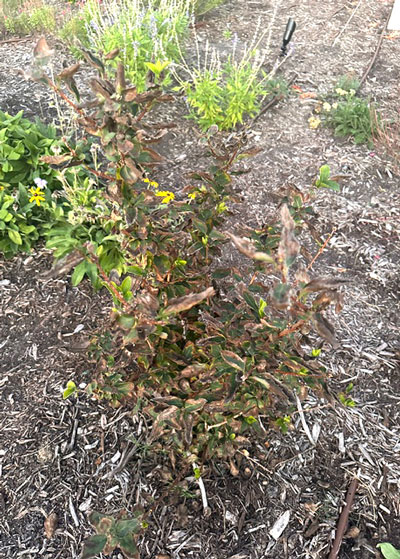
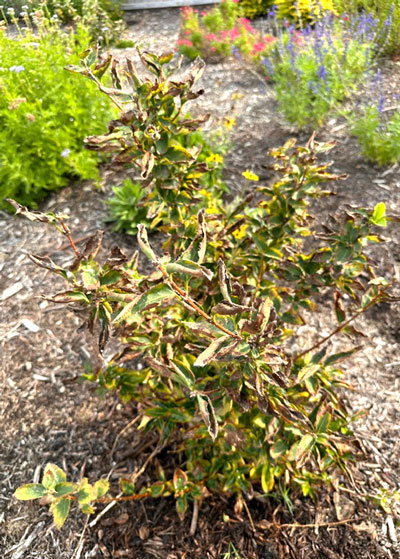
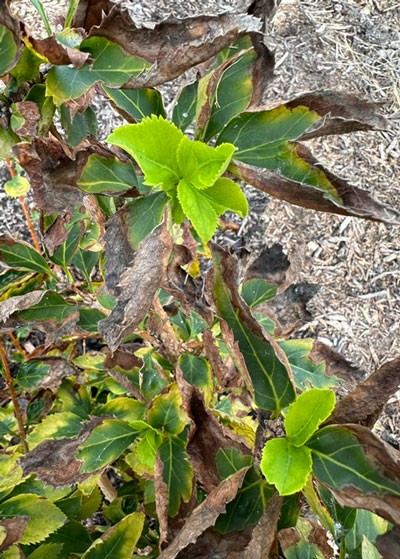
Answer: The neglect came from letting it get too dry. I did my research for my Master’s Degree using forsythias as my test plants, so know their habits quite well. They grow vigorously if they’re kept moist at all times – not wet, just uniformly moist. When leaves turn brown at the tips and around their margins, they haven’t been able to get enough water through the entire plant.
The good news is that forsythias are very forgiving. When you finally do get water to them they will start putting out new growth. You’re seeing that now. Keep doing it. No other call to action.
QUESTION 5
HOW LONG DO I RUN MY DRIP SYSTEM AND HOW MANY DAYS?
Question: I have the drip system and I need help on how long to run it and how many days. I have it in all my beds and I have had plants struggle. Are there any set rules for the system in Texas’ hot summers? Nell D., Granbury.
Answer: Your wording suggests that there might be only one type of drip irrigation system. In reality there are scores of brands and infinite variations. All of that alone would make it impossible to give you a good answer, but then you have to add in the type of soil you have and the species of plants you’re trying to irrigate. Duration and frequency must be determined by the gardener using his or her fingers (to feel the soil) and eyes (to monitor the plants). Remember that you want to water deeply to encourage deep root growth and less frequently to encourage the roots to grow down seeking that water. You must constantly check to be sure that the emitters are functioning properly. Once every 4 or 5 weeks it’s a good plan during dry spells to water from above to leach excess minerals out of the soil.
QUESTION 6
SHOULD I HAVE BEEN TRIMMING MY YELLOW BELLS ESPERANZA TO KEEP IT FROM GETTING TOO TOP HEAVY? IT BROKE.
Question: My yellow bells Esperanza was looking glorious this summer, then all of a sudden it snapped and fell over. Should I have been trimming it back to keep it from getting too top heavy? Karen V., Salado.
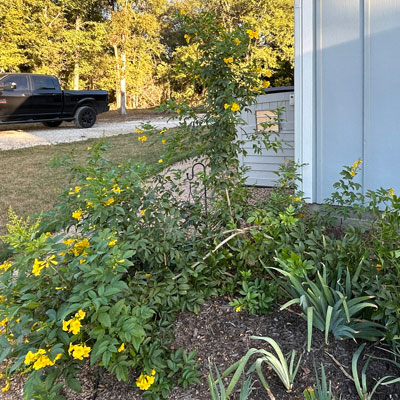
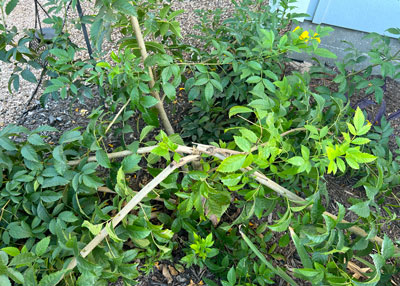
Answer: It would be better, perhaps, to set a stout post right alongside the Esperanza plant for support. Either a 4×4 or a cedar post of equivalent size. Let it extend 18 ins. Into the soil and 4 or 4-1/2 ft. above ground and you should have all the support you need. That’s a great plant, although it does have a problem determining if it’s a shrub, a vine, or a “leaner.” It’s best to plan for the last one.
QUESTION 7
WHY DOES MY LAWN HAVE FADED PATCHES NOW?
Question: I have had a green St. Augustine lawn all summer. In early September I applied a slow-release fertilizer, then the pre-emergent Dimension, and then Gallery pre-emergent for broadleafed weeds. My lawn has large patches that aren’t growing and that appear faded now. Other parts are fine and green. What gives? Sean B., College Station.
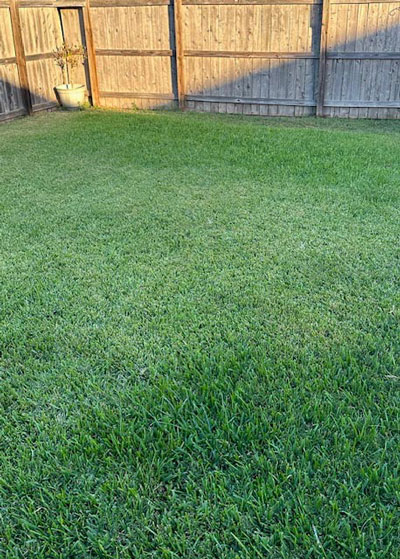
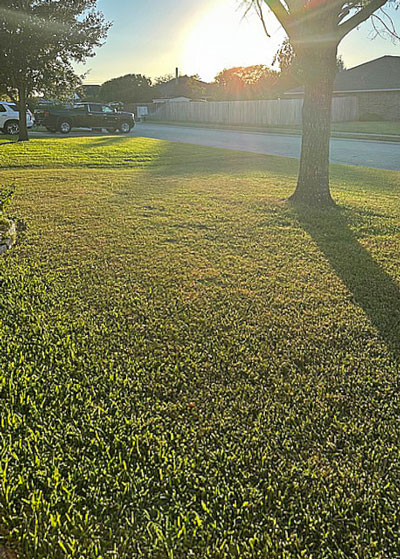
Answer: I had a little trouble telling for sure from your photos. I suspect it might be brown patch, now being called “large patch” by the TAMU turf authorities. It’s a fall cool-season disease that starts by turning leaves in affected areas yellowish, then yellow, then brown very rapidly – start to finish, in just a week or two. It attacks the grass blades where they attach to the runners. When you pull on the blades they come loose easily from the runners, and you’ll be able to see the decay. If that proves true, apply Azoxystrobin or other fungicide labeled for patch diseases. Discontinue all watering at night. If that’s not what you discover, I’ll need clearer photographs.
